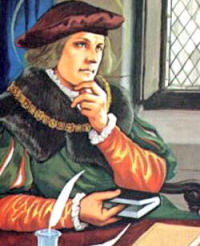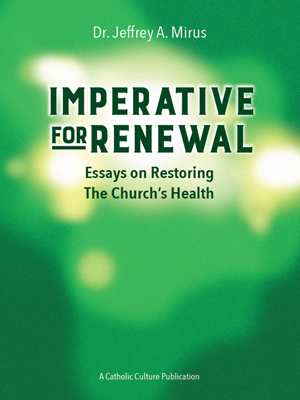Ordinary Time: June 22nd
Optional Memorial of St. Paulinus of Nola, bishop and confessor; Optional Memorial of Sts. John Fisher, bishop and martyr and Thomas More, martyr
Other Commemorations: St. Alban, Martyr (RM)
» Enjoy our Liturgical Seasons series of e-books!
St. Thomas More was born in London, England and was Chancellor of King Henry VIII. As a family man and a public servant, his life was a rare synthesis of human sensitivity and Christian wisdom.
St. John Fisher studied Theology in Cambridge (England) and became Bishop of Rochester. His friend, Thomas More, wrote of him, 'I reckon in this realm no one man, in wisdom, learning and long approved virtue together, meet to be matched and compared with him.' He and his friend St. Thomas More gave up their lives in testimony to the unity of the Church and to the indissolubility of Marriage.
St. Paulinus was born of a patrician Roman family at Bordeaux. He was successively prefect, senator and consul. His wife, wishing to consecrate herself to God, gave up rank and riches; he followed her example and went to live an austere hermit's life at Nola in Italy. There he became a priest and then bishop of the city, and gave his people not only an example of virtue but also wise guidance during the ravages and calamities of the Gothic invasion. He died in 431, aged 78, and was buried at Nola near the tomb of St. Felix.
According to the 1962 Missal of St. John XXIII the Extraordinary Form of the Roman Rite, today is the feast of St. Alban who was venerated as the proto-martyr of Britain. He was a citizen of Verulam and was converted by a persecuted priest whom he sheltered in his house. He was executed on Holmhurst Hill. On that spot King Offa erected the Benedictine abbey of St. Alban's by which name Verulam has since been known.
St. Thomas More
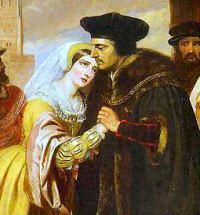 His belief that no lay ruler has jurisdiction over the church of Christ cost Thomas More his life.
His belief that no lay ruler has jurisdiction over the church of Christ cost Thomas More his life.
Beheaded on Tower Hill, London, July 6, 1535, he steadfastly refused to approve Henry VIII's divorce and remarriage and establishment of the Church of England.
Described as "a man for all seasons," More was a literary scholar, eminent lawyer, gentleman, father of four children and chancellor of England. An intensely spiritual man, he would not support the king's divorce from Catherine of Aragon in order to marry Anne Boleyn. Nor would he acknowledge Henry as supreme head of the church in England, breaking with Rome and denying the pope as head.
More was committed to the Tower of London to await trial for treason: not swearing to the Act of Succession and the Oath of Supremacy. Upon conviction, More declared he had all the councils of Christendom and not just the council of one realm to support him in the decision of his conscience.
Four hundred years later, in 1935, Thomas More was canonized a saint of God. Few saints are more relevant to our time. In fact, in 2000, Pope John Paul II named him patron of political leaders. The supreme diplomat and counselor, Thomas More did not compromise his own moral values in order to please the king, knowing that true allegiance to authority is not blind acceptance of everything that authority wants. Henry himself realized this and tried desperately to win his chancellor to his side because he knew More was a man whose approval counted, a man whose personal integrity no one questioned. But when Thomas resigned as chancellor, unable to approve the two matters that meant most to Henry, the king felt he had to get rid of Thomas.
—Excerpted from Saint of the Day, Leonard Foley, O.F.M.
Patronage: Declared in 2000 by St. John Paul II patron of statesmen and politicians; Adopted children; diocese of Arlington, Virginia; civil servants; court clerks; difficult marriages; large families; lawyers; diocese of Pensacola-Tallahassee Florida; politicos; step-parents; widowers.
Symbols and Representation: axe; English Lord Chancellor carrying a book; English Lord Chancellor carrying an axe
Highlights and Things to Do:
- A Man for All Seasons by Robert Bolt is a wonderful play that captures much of St. Thomas More's vitality. There is a 1966 movie by the same title that stars Paul Scofield as St. Thomas. If you haven't watched the movie or read the play yet, put it on your priority list.
- Listen to the Catholic Culture Criteria podcasts about A Man for All Seasons:
- From Stage to Screen: A Man for All Seasons (1966), James Majewski and Thomas Mirus discuss the film and the problem of adaptation with friend and filmmaker, Nathan Douglas.
- Robert Bolt’s Man for All Seasons: Christian saint or “hero of selfhood”?, Thomas Mirus asks attorney and scholar Louis Karlin whether Robert Bolt’s play and film A Man for All Seasons accurately depict St. Thomas More’s views on the rights of conscience, and his motives for martyrdom
- Listen to Catholic Culture's audiobooks of Thomas More:
- Dialogue on Conscience read by James Majewski
- St. Thomas More—Poems from the Tower of London read by James Majewski
- Listen to the Catholic Culture Podcast Ep. 69—Poetry of the English Martyrs—Benedict Whalen
- Read Jeff Mirus' commentary, St. Thomas More’s razor-sharp “Dialogue of Comfort”.
- Book recommendation, more on the life of St. Thomas More. For youth, Saint Thomas More of London by Elizabeth Ince, a reprint of the wonderful Vision Books series. For adults, the newer book The King's Good Servant but God's First : The Life and Writings of Saint Thomas More by James Monti which explores the life and writings of St. Thomas More. Also Scepter Publishers has a biography Thomas More: A Portrait of Courage by Gerard B. Wegemer.
- For some writings by St. Thomas More, see The Sadness of Christ (Yale University Press Translation) and Four Last Things: The Supplication of Souls: A Dialogue on Conscience.
- If you or your children are considering a career as a lawyer you might find Dr. Charles Rice's article helpful.
- Read more about St. Thomas More:
- Watch this YouTube video on St. Thomas More.
- Read the commentary on the Trial of St. Thomas More.
- Read about the Thomas More Society, a not-for-profit, national public interest law firm dedicated to restoring respect in law for life, family, and religious liberty here..
- St. Thomas More's headless body is located in Tower of London Chapel Royal of St Peter ad Vincula. His head is located in St Dunstan’s Church in Canterbury, United Kingdom, buried in the crypt of the Roper Chapel together with the remains of Margaret and son-in-law, William Roper.
- See Catholic Cuisine for a clever food idea.
St. John Fisher
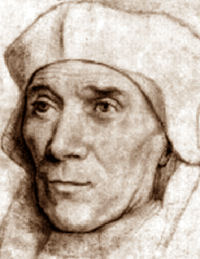 John Fisher is usually associated with Erasmus, Thomas More and other Renaissance humanists. His life, therefore, did not have the external simplicity found in the lives of some saints. Rather, he was a man of learning, associated with the intellectuals and political leaders of his day. He was interested in contemporary culture and eventually became chancellor at Cambridge. He had been made a bishop at thirty-five, and one of his interests was raising the standard of preaching in England. Fisher himself was an accomplished preacher and writer. His sermons on the penitential psalms were reprinted seven times before his death. With the coming of Lutheranism, he was drawn into controversy. His eight books against heresy gave him a leading position among European theologians.
John Fisher is usually associated with Erasmus, Thomas More and other Renaissance humanists. His life, therefore, did not have the external simplicity found in the lives of some saints. Rather, he was a man of learning, associated with the intellectuals and political leaders of his day. He was interested in contemporary culture and eventually became chancellor at Cambridge. He had been made a bishop at thirty-five, and one of his interests was raising the standard of preaching in England. Fisher himself was an accomplished preacher and writer. His sermons on the penitential psalms were reprinted seven times before his death. With the coming of Lutheranism, he was drawn into controversy. His eight books against heresy gave him a leading position among European theologians.
In 1521 he was asked to study the problem of Henry VIII's marriage. He incurred Henry's anger by defending the validity of the king's marriage with Catherine and later by rejecting Henry's claim to be the supreme head of the Church of England.
In an attempt to be rid of him, Henry first had him accused of not reporting all the "revelations" of the nun of Kent, Elizabeth Barton. John was summoned, in feeble health, to take the oath to the new Act of Succession. He and Thomas More refused because the Act presumed the legality of Henry's divorce and his claim to be head of the English church. They were sent to the Tower of London, where Fisher remained fourteen months without trial. They were finally sentenced to life imprisonment and loss of goods.
When the two were called to further interrogations, they remained silent. Fisher was tricked, on the supposition he was speaking privately as a priest, and declared again that the king was not supreme head. The king, further angered that the pope had made John Fisher a cardinal, had him brought to trial on the charge of high treason. He was condemned and executed, his body left to lie all day on the scaffold and his head hung on London Bridge. More was executed two weeks later.
—Excerpted from Saint of the Day, Leonard Foley, O.F.M.
Patronage: Those persecuted for the Faith; diocese of Rochester, New York
Symbols and Representation: Martyrs' Palm; cardinal with an axe nearby; cardinal with his hat at his feet; cardinal with worn, haggard features
Highlights and Things to Do:
- Read more about St. John Fisher:
- Read St. John Fisher's Commentary or Exposition of the Seven Penitential Psalms, Volume I and Volume II at Internet Archive.
- Read St. John Fisher, the Martyr Overshadowed by St. Thomas More.
- The headless body of St. John Fisher is located in Tower of London Chapel Royal of St Peter ad Vincula.
St. Paulinus of Nola
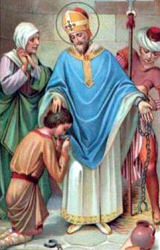 In 353 Pontius Meropius Anicius Paulinus was born of a prominent Bordeaux family. He received his education in the school of the rhetorician Ausonius. At an early age he attained the dignity of senator and then of consul. As governor of Campania, he chose Nola as his seat. Here he was converted to the faith by St. Felix of Nola. He resigned his position and returned to Gaul, where St. Martin of Tours restored his eyesight.
In 353 Pontius Meropius Anicius Paulinus was born of a prominent Bordeaux family. He received his education in the school of the rhetorician Ausonius. At an early age he attained the dignity of senator and then of consul. As governor of Campania, he chose Nola as his seat. Here he was converted to the faith by St. Felix of Nola. He resigned his position and returned to Gaul, where St. Martin of Tours restored his eyesight.
Despite personal remonstrances, Paulinus was ordained a priest in Spain, and from there he returned to do honor at the grave of his sainted spiritual father. In 409 he became bishop of Tours. Paulinus was an author and poet; he corresponded with the great saints and scholars of his time, Ambrose and Augustine. During the Vandal invasion he used every possible means to feed the poor. When a poor widow asked for money to ransom her son, he gave himself into slavery. With God's aid he returned to his flock and died at the age of seventy-eight in 431. His last words were: "I will prepare a lamp for My anointed" (Ps. 131). His particular virtue was love toward the poor.
—Excerpted from The Church's Year of Grace, Pius Parsch
Highlights and Things to Do:
- Read more about St. Paulinus:
- See where St. Pauline' relics reside: Saints In Rome & Beyond.
- Read Pope Benedict's General Audience Address on Saint Paulinus of Nola.
St. Alban
 St. Alban was the first Christian martyr (protomartyr) in Britain during the early 4th century. He is the patron saint of converts and torture victims.
St. Alban was the first Christian martyr (protomartyr) in Britain during the early 4th century. He is the patron saint of converts and torture victims.
Although he was not a man of faith, St. Alban was very hospitable and compassionate. As a soldier, he sheltered a persecuted priest, Amphibalus, during a time when Christians were being put to death in Britain. The priest's faith and piety struck St. Alban, as well as his dedication to prayer.
Alban soon converted to Christianity.
In an effort to help the priest escape, he switched clothes with him. But Alban was caught and ordered to renounce his faith. St. Alban refused to worship idols, and when asked to state his name, answered “My name is Alban, and I worship the only true and living God, who created all things.
For his refusal to deny his beliefs, he was to be tortured and beheaded. The person first selected to execute Alban heard his testimony and converted on the spot. After refusing to kill Alban, he was executed as well.
A number of other conversions are claimed to have happened thanks to the witness of St. Alban’s martyrdom, specifically on behalf of spectators of his execution.
Finally, when the priest learned that Alban was arrested in his place, he turned himself in, hoping to save Alban’s life. But that wasn’t the case. The priest was killed as well.
St. Alban’s Cathedral now stands near the execution site. The town where he was born was also renamed after him.
—Excerpted from Catholic News Agency
Highlights and Things to Do:
- Learn more about St. Alban:
- Read St. Alban, Protomartyr of Britain, from Bede, Usher’s Collections, &c., his Ancient Life, and the English-Saxon abstract of it, in Bibl. Cotton. Julius, A. x.
- St. Alban's Cathedral was built over his grave.
- Hot Cross Buns originated from St. Alban's Abbey which was the original location of the now St. Alban's Cathedral.





